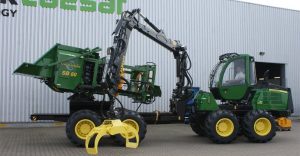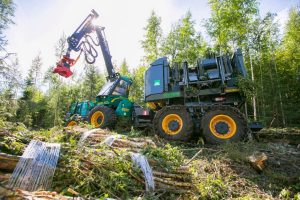Some 20 years ago bundlers for forest residue were the thing. Timberjack (nowadays John Deere) had one, Valmet (nowadays Komatsu) had one, and several other brands and models were available on the market. Then they disappeared just as suddenly as they turned up. What happened?
Bundlers – A good idea at the time
The idea was to make the handling of forest residue more efficient. To chip the material at terminals instead of in the forest. At a terminal, larger and more efficient chippers could be used, and the logistics around them were easier to organize at a terminal than in the forest. For this, a system was needed to transport the residue from the forest to the terminals.
There were already such systems available. Specially designed forwarders and trucks that could bring the slash to a terminal, preferably close to the heating plant, to be chipped. The problem was the specially designed vehicles. The new idea was to create a system where normal forwarders and timber trucks could be used, without any special features. Therefore, the slash had to be processed into something that looked like logs and could be handled by timber grapples.
Two at the same time
For a short period, I was involved in the development of one of the concepts, the Woodpac. A friend of mine was involved as a part-owner in the project and asked me to join as a test pilot. I had never heard of it but thought it sounded like an exciting project to be a part of. So, I joined the team.
The idea with the Woodpac was to roll the slash into a bundle, like rolling a cigarette, tie a string around it, and let it out. The trick was to make it firm enough to be handled like a log. It worked – sometimes. The development work was very interesting. I learned a lot, for example, that making the theory work in practice can be very difficult. Here is a film of the Woodpac on a Valmet forwarder.
Little did we in the crew at Woodpac know that there was another similar project going on simultaneously, the Fiberpac. The end-product, the “slash log”, looked almost the same from the two. But the Fiberpac made an infinite log that was cut into lengths with a saw bar, like a harvester.
Photo: John Deere
Eventually, the Fiberpac ended up in the Timberjack range and the Woodpac in the Valmet range.
End of story(?)
The concept didn´t quite live up to the expectations. The Swedish traffic authorities had views on transporting slash on trucks with open sides, timber trucks. They saw an obvious risk that log parts and branches could come loose and fall on meeting cars etc. Suddenly, using timber trucks as they were, was not possible.
In the meantime, the logistics around slash handling became more efficient and finally, there was no point in bundling the slash. In Sweden the idea was short-lived. The Woodpac disappeared. The Fiberpac and Timberjack/John Deere went on, but mainly in other countries. In 2017, Dutch Dragon took over the Fiberpac from John Deere. It´s however unclear to me if the Fiberpac bundler is still available on the market today.
The story could have taken another turn if it would have been possible to burn the bundles without chipping them. This was tested, but apparently, it didn´t turn out to the advantage for the bundlers. If that had worked, it probably would have been worth using special trucks for the transport of the bundles. The forwarders could still have been used without any special equipment.
Not only slash was bundled
Around 2010, the brother of the famous Lars Bruun, Gösta Bruun, came up with the idea to chip slash in the forest and pack it into a plastic “sausage”. The machine was called Flispac (“chip-PAC”). The idea was that a harvester should have the Flispac at the back and put the tops of the processed trees in it to be chipped and packed into a plastic “log” or “sausage”. The chip logs should then be forwarded together with the pulpwood and timber.
This never broke through. I guess that the system was too expensive to motivate this extra equipment on a harvester. I once spoke with Gösta about it, and he told me that there was a problem opening the logs and getting rid of the plastic when handling the chips at the heating plant. I never heard that this problem was solved. Anyway, the company doesn´t exist anymore.
Here is a film from a test of the chipper/bundler.
Some are still bundling
Woodpac and Fiberpac were not the only ones working on bundlers. Machines for bundling, and bundles, in different shapes and sizes, were tested, but none of them made a major impact on the market. Maybe with one exception:
The Finnish company Fixteri Oy offers a bundler for thin stems and tops. The bundles remind a lot of those from Woodpac and Fiberpac. The difference is that the Fixteri doesn´t handle pure slash.
Photo: Fixteri Group Oy
I’m sure there are bundlers that I have forgotten or never heard of. Somewhere deep in my mind, I recall that there is something Woodpac-like in Spain … But I haven´t managed to get that confirmed.













